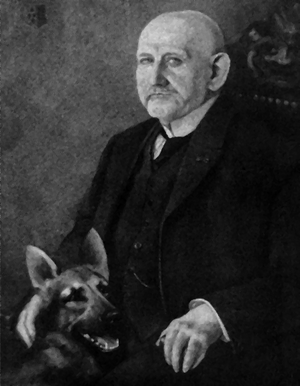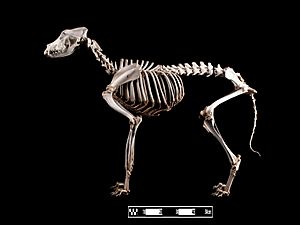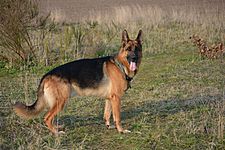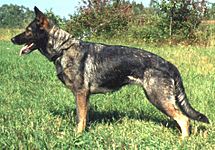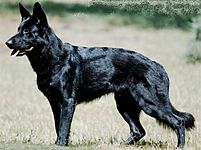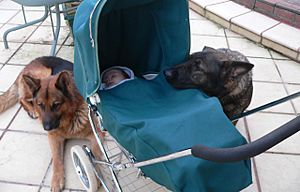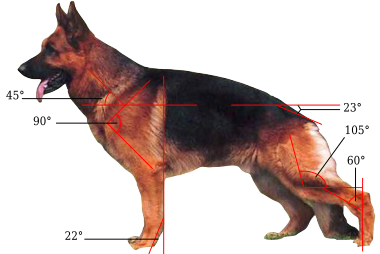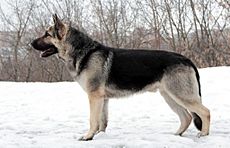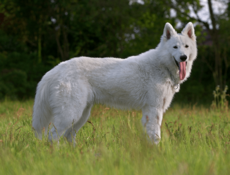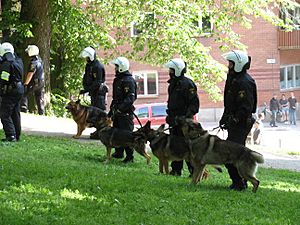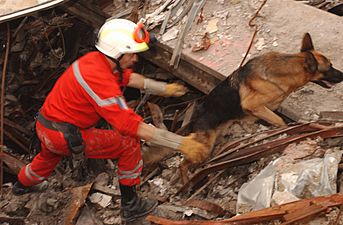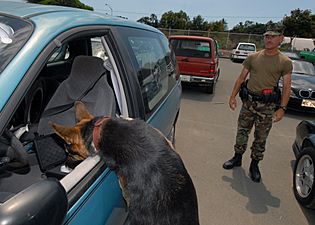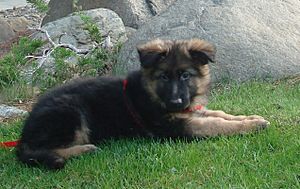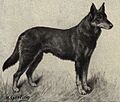German Shepherd facts for kids
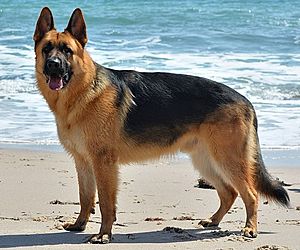
Adult male
|
|||||||||||||||||||||||||
| Other names |
|
||||||||||||||||||||||||
|---|---|---|---|---|---|---|---|---|---|---|---|---|---|---|---|---|---|---|---|---|---|---|---|---|---|
| Origin | Germany | ||||||||||||||||||||||||
|
|||||||||||||||||||||||||
|
|||||||||||||||||||||||||
| Domestic dog (Canis lupus familiaris) | |||||||||||||||||||||||||
The German Shepherd, also known as an Alsatian in Britain, is a medium to large-sized dog breed from Germany. This breed was created by Max von Stephanitz starting in 1899. He used different types of traditional German herding dogs to develop it.
German Shepherds were first bred to herd sheep. They are now used for many other important jobs. These include helping people with disabilities, finding missing people, police work, and even military tasks. Many people also keep them as pets. In 2013, they were the second most registered dog breed in the world.
Contents
- History of the German Shepherd Dog
- What German Shepherds Look Like
- German Shepherd Diet
- German Shepherd Temperament
- Modern German Shepherd Breeding
- German Shepherd Varieties
- German Shepherds as Working Dogs
- German Shepherd Popularity
- German Shepherd Health
- Famous German Shepherds
- Images for kids
- See also
History of the German Shepherd Dog
In the 1890s, people wanted to make dog breeds more alike. Shepherds bred dogs to keep traits that helped them herd sheep. They also wanted dogs that could protect flocks from wild animals. In Germany, shepherds chose and bred dogs in their local areas. They knew these dogs were smart, fast, strong, and had a great sense of smell. These dogs were good at herding, but they looked and acted very differently from place to place.
To fix these differences, the Phylax Society was formed in 1891. Their goal was to create clear plans for German dog breeds. But the group broke up after only three years. Members argued about what traits dogs should have. Some thought dogs should only be bred for work. Others believed looks were also important. Even though they failed, the Phylax Society inspired others to try to standardize dog breeds on their own.
As big cities grew in Germany, fewer wild animals were around. This meant sheepdogs were not as needed for herding. At the same time, people started to see sheepdogs as smart and useful for many things. Max von Stephanitz, a former army captain and veterinary student, was a member of the Phylax Society. He strongly believed dogs should be bred for work. He admired the intelligence and strength of Germany's sheepdogs. But he could not find one perfect working dog breed.
In 1899, von Stephanitz saw a dog named Hektor Linksrhein at a dog show. Hektor was the result of careful breeding. He was exactly what von Stephanitz thought a working dog should be. He was impressed by the dog's strength, intelligence, loyalty, and beauty. He bought Hektor right away and renamed him Horand von Grafrath. Von Stephanitz then started the Verein für Deutsche Schäferhunde (Society for German Shepherd Dogs). Horand was named the first German Shepherd Dog. He was also the first dog added to the society's breed list.
In just a few decades, the German Shepherd became one of the most popular breeds. It has stayed popular ever since. By 1923, the society had 50,000 members in Germany alone. Horand became the main dog for breeding. He was bred with other dogs that had good traits. He also bred with dogs from different German regions. Horand had many puppies. His most famous was Hektor von Schwaben. Hektor was bred with other dogs from Horand's family. This led to pups like Heinz von Starkenburg, Beowulf, and Pilot. Pilot later had 84 puppies, mostly by breeding with Hektor's other offspring. This close breeding was done to make sure the desired traits stayed in the breed. All German Shepherds today can trace their family tree back to Beowulf's puppies. Many believe von Stephanitz's strong leadership helped the society reach its goals. He is known as the creator of the German Shepherd Dog.
During the early 1900s, the breed became linked with Germany's government at the time. This was because of its connection to ideas of purity and military strength. German Shepherds were seen as "original German dogs," close to wolves. They became very popular during the Nazi era. Adolf Hitler got a German Shepherd named "Prinz" in 1921. He loved the dog's loyalty and obedience. Hitler owned several more German Shepherds, including Blondi. Blondi was with him during the end of World War II. Dogs were used in propaganda to show Hitler as an animal lover. German Shepherds were also used as guard dogs in Nazi camps.
When German Shepherds first came to the United States, they were very popular. But as they became more common, they were sometimes seen as dangerous. This was because gangsters and bootleggers owned them. Their reputation as dangerous dogs grew so much that Australia briefly banned importing them in 1929. There was even talk of making all German Shepherds in South Australia be spayed or neutered.
How the German Shepherd Got Its Name
Max von Stephanitz named the breed Deutscher Schäferhund. This means "German Shepherd Dog." At that time, all other herding dogs in Germany were called by this name. So, they became known as Altdeutsche Schäferhunde, or old German herding dogs.
The direct translation of the name was used in the official dog records. However, after World War I, people thought the word "German" would hurt the breed's popularity. This was because of strong anti-German feelings at the time. So, the UK Kennel Club officially renamed the breed "Alsatian Wolf Dog." This name came from Alsace, a French region next to Germany.
Later, the "wolf dog" part was removed. Breeders worried that being called a wolf-dog hybrid would make the breed less popular or even illegal. The name "Alsatian" stayed for 50 years. Then, in 1977, dog lovers pushed British kennel clubs to allow the breed to be called German Shepherds again. The American Kennel Club also used "Alsatian" in parentheses for a while, but removed it in 2010.
What German Shepherds Look Like
German Shepherds are medium to large-sized dogs. Males are usually 60 to 65 centimeters (24 to 26 inches) tall at the shoulder. Females are 55 to 60 centimeters (22 to 24 inches) tall. These dogs can run very fast, up to 30 miles per hour.
They are longer than they are tall. Their body shape is ideally 10 parts long for every 8.5 parts tall. The official breed standard does not set a weight range. They have a rounded forehead and a long, square-shaped muzzle. Their jaws are strong, and their nose is black. Their eyes are medium-sized and brown. Their ears are large and stand straight up. They face forward but can be pulled back when the dog moves quickly. A German Shepherd has a long neck. It is raised when they are excited and lowered when they run fast or stalk. Their tail is bushy and reaches their hock (the joint on their back leg).
German Shepherds have a double coat. This means they have a thick undercoat and a dense outer coat. The coat comes in two types: medium and long. The gene for long hair is recessive, so long-haired dogs are rarer. How long-haired German Shepherds are treated varies by different dog clubs. Some accept them but do not let them compete against standard-coated dogs. Others allow them to compete but consider long hair a fault. In 2010, the FCI (a big international dog organization) accepted the long-haired type.
Most German Shepherds are tan and black or red and black. Many have black "masks" on their faces. They also have black markings on their bodies, like a "saddle" or a full "blanket." Rarer colors include sable, solid black, pure white, liver (brown), silver, blue, and panda. Solid black and sable colors are usually allowed. However, blue and liver are seen as serious faults. All-white German Shepherds are usually not allowed in dog shows.
German Shepherd Intelligence
German Shepherds were specifically bred to be smart. In a list of breeds that bark the most as watchdogs, they were ranked second. Their intelligence, combined with their strength, makes them great police, guard, and search and rescue dogs. They can learn tasks quickly and understand instructions better than many other breeds.
German Shepherd Diet
Most German Shepherds eat dog food made for them. This food has the right mix of nutrients dogs need. No matter what food you choose, it should have these important parts:
- Protein: This is super important for building and fixing muscles. Good sources are meat (like chicken, beef, lamb), fish, and eggs.
- Fats: Fats give energy and help the body use certain vitamins. Healthy fats come from things like chicken fat, fish oil, and vegetable oils.
- Carbohydrates: Carbs also give energy. Good sources include grains (like rice, barley, oats), vegetables (like sweet potatoes, peas), and fruits.
- Vitamins: These help with many body functions. Examples are Vitamin A (good for vision), B vitamins (help with energy), Vitamin C (helps the immune system), Vitamin D (helps with bones), Vitamin E (good for skin), and Vitamin K (helps blood clot).
- Minerals: These are also key for many body processes. Examples include Calcium and Phosphorus (for bones and teeth), Potassium (for nerves and muscles), Sodium (helps balance fluids), Magnesium (helps muscles and nerves), Zinc (helps the immune system and skin), Iron (helps carry oxygen in the blood), and Selenium (helps protect cells).
How to Feed Your German Shepherd
Most dog food bags have guides based on your dog's weight. These are a good start. But you should also check your dog's body. You should be able to feel their ribs easily, but not see them sticking out. Their waist should be clear when you look down at them.
- Puppies (up to about 6-12 months): They usually eat 3-4 smaller meals each day. This helps their digestion and gives them steady energy for growing.
- Adults (about 1-7 years): They usually eat 2 meals per day (morning and evening).
- Seniors (about 7+ years): They may eat 2 meals per day. Sometimes they need food made for older dogs. This food might have different nutrient levels to help their aging bodies.
Fresh, clean water is just as important as food. Dogs need water all the time. Water helps with digestion, controls body temperature, and is part of almost every body process. Always make sure their water bowl is full and clean.
Many human foods are dangerous or unhealthy for dogs. It is very important to know these and make sure your German Shepherd never eats them:
- Chocolate: Has things that are poisonous to dogs. Dark chocolate is the most dangerous.
- Onions and Garlic: Can harm a dog's red blood cells.
- Grapes and Raisins: Can cause kidney problems in some dogs.
- Avocado: Has a substance called persin that can be bad for dogs in large amounts.
- Xylitol: An artificial sweetener in some sugar-free foods (like gum, candy, peanut butter). It is very toxic and can cause a sudden drop in blood sugar and liver problems.
- Bones (cooked): Cooked bones can break into sharp pieces. These can cause serious harm inside a dog. Raw bones can be given carefully, but many experts advise against them due to risks like choking or broken teeth.
- High-Fat Foods: Can cause an upset stomach or a serious condition called pancreatitis.
- Foods with Yeast Dough: Can grow in the stomach and cause painful gas or blockages.
German Shepherd Temperament
German Shepherds are active dogs. Breed standards describe them as self-assured. They are eager to learn and want to have a job to do. They are curious, which makes them great guard dogs and good for search missions. They can become very protective of their family and home. This is especially true if they are not socialized well when they are young. They do not usually become friends with strangers right away. German Shepherds are very smart and obedient. They are also protective of their owners.
Understanding German Shepherd Bites
A study looked at dog bites that needed hospital care in the United States from 1971 to 2018. It found that German Shepherds were involved in the most severe bites among purebred dogs.
An Australian report from 1999 showed that German Shepherds were the third most likely breed to bite a person in some areas. However, when you consider how popular they are, the percentage of attacks by German Shepherds drops to 38th place.
The TV show Dangerous Encounters said that a German Shepherd's bite force is over 238 pounds of force. This is strong, but less than a Rottweiler (over 265-328 pounds of force). A Pit bull has about 235 pounds of force, and a Labrador Retriever has about 230 pounds of force. A human bite is about 86 pounds of force.
Modern German Shepherd Breeding
Experts criticize how modern German Shepherds are bred. They say it has moved away from Max von Stephanitz's original idea. He believed German Shepherds should be bred mainly as working dogs. He also thought breeding should be strictly controlled to quickly remove any problems. He felt that intelligence and working ability were the most important traits for German Shepherds.
German Shepherd Varieties
East-European Shepherd
The East-European Shepherd is a type of German Shepherd. It was bred in the former Soviet Union. The goal was to create a larger German Shepherd that could handle cold weather better. This variety does not have the body problems seen in some Western show German Shepherds. It has become one of Russia's most popular dog types.
King Shepherd
The King Shepherd is a type of German Shepherd bred in the United States. Its breeders hoped to fix the body problems that have been bred into the original German Shepherd breed.
Shiloh Shepherd
The Shiloh Shepherd is another type of German Shepherd from the United States. It was developed in the 1970s and 1980s. Breeders wanted to fix behavior and body shape issues in modern German Shepherds. They bred for large size, long backs, good temperaments, and healthy hips. The American Rare Breed Association has recognized it as a breed since 1990.
White Shepherd
The White Shepherd is a type of German Shepherd bred in the United States. White-coated German Shepherds were once not allowed to be registered in Germany. But in the United States and Canada, the white color became popular. A breed club was formed just for white German Shepherds, calling their type the White Shepherd. The United Kennel Club recognizes it as a separate breed.
White Swiss Shepherd Dog
The White Swiss Shepherd Dog is a type of German Shepherd bred in Switzerland. It came from American White Shepherds. The first male dog used for breeding this type was an American dog born in 1966 and brought to Switzerland. The Fédération Cynologique Internationale recognized it as a separate breed in 2003. Now, many national kennel clubs recognize it.
German Shepherds as Working Dogs
German Shepherds are a popular choice for working dogs. They are known for being easy to train. They are good at doing tasks and following instructions. They are especially famous for police work. They track criminals, patrol busy areas, and find and hold suspects. Thousands of German Shepherds have also served in the military. These military working dogs (MWD) are often trained for scouting. They warn soldiers about enemies, booby traps, or other dangers. German Shepherds have also been trained to parachute from planes or act as anti-tank weapons. In World War II, they were used as messenger dogs, rescue dogs, and personal guard dogs. Many soldiers were impressed by their intelligence and took these dogs home.
The German Shepherd is one of the most used breeds for jobs involving smell. These include search and rescue, finding bodies, narcotics detection, explosives detection, finding fire starters, and mine detection. They are good at these jobs because of their strong sense of smell. They can also work well even with distractions. At one time, German Shepherds were almost the only breed chosen as guide dogs for the visually impaired. When guide dog training started in Switzerland in the 1920s, all the dogs trained were female German Shepherds. Later, a test compared Labrador Retrievers and German Shepherds. Labradors scored higher in being calm, recovering from scary situations, being cooperative, and being friendly. German Shepherds were better at being aggressive and defensive. This suggested Labradors were better for guide dog work, while German Shepherds were better for police work.
Today, Labradors and Golden Retrievers are more commonly used as guide dogs. However, some German Shepherds are still trained for this work. In 2013, about 15% of the dogs trained by Guide Dogs of America were German Shepherds. The rest were Labradors and Golden Retrievers. The Guide Dogs for the Blind Association in the United Kingdom trains some German Shepherds. But the similar group in the US only trains Labradors, Golden Retrievers, and mixes of these breeds.
German Shepherds are still used for herding sheep in fields near gardens and crops. They are expected to patrol the edges to keep sheep from going into and damaging the crops. In Germany and other places, these skills are tested in special trials. These are called Herdengebrauchshund (HGH) herding utility dog trials.
German Shepherd Popularity
When the UK Kennel Club started registering German Shepherds in 1919, there were 54 dogs. By 1926, this number grew to over 8,000. The breed became known worldwide after World War I. Soldiers returning home spoke highly of the breed. Dog actors like Rin Tin Tin and Strongheart made the breed even more popular. The first German Shepherd Dog registered in the United States was Queen of Switzerland. Her puppies had problems due to poor breeding. This caused the breed's popularity to drop in the late 1920s.
Popularity rose again after Sieger Pfeffer von Bern won top awards in American Kennel Club dog shows in 1937 and 1938. But it dropped again after World War II because of anti-German feelings. Popularity slowly increased until 1993, when they became the third most popular breed in the United States. As of 2016, the German Shepherd is the second most popular breed in the US. It is often one of the most registered breeds in other countries too. In 2020, it was the third most registered breed by the American Kennel Club. In 2016, it was the seventh most registered breed by The Kennel Club in the United Kingdom.
German Shepherd Health
Many common health issues in German Shepherds come from the close breeding done early in the breed's history. One common problem is hip and elbow dysplasia. This can cause pain later in the dog's life and may lead to arthritis. A study found that 45% of police German Shepherds had a spinal problem called degenerative spinal stenosis. However, this study used a small number of dogs. The Orthopedic Foundation for Animals found that 19.1% of German Shepherds have hip dysplasia.
There are ways to help prevent hip dysplasia. You can get a puppy from a good breeder. Keep your dog on a healthy diet. Also, limit how much they jump or play roughly. German Shepherds do not get ear infections very often. This is because their earwax glands are very active. A recent survey in the UK found that German Shepherds live for about 10.95 years on average. This is a normal lifespan for a dog of their size.
Degenerative myelopathy is a brain and spinal cord disease. It happens often enough in German Shepherds to suggest they are more likely to get it. There is a very cheap DNA saliva test to check for this disease. The test looks for a changed gene found in dogs with degenerative myelopathy. A small study in the UK showed that 16% of young German Shepherds had two copies of this changed gene, even without symptoms. Another 38% were carriers. Now that a test is available, breeders can try to remove this disease from the breed. The test is only suggested for breeds that are prone to it. But it can be done on any dog's DNA from a cheek swab. People buying German Shepherds can ask the breeder for this test. Or they can buy from a breeder who is known to test their dogs.
German Shepherds have a higher chance of getting Von Willebrand disease. This is a common bleeding problem that can be passed down. They also have a higher chance of getting exocrine pancreatic insufficiency (EPI). This is a disease where the pancreas does not work well. About 1% of German Shepherds in the UK have EPI. Treatment usually involves giving pancreatic supplements with food.
Vitamins like A and D are also very important for bone growth and health. They help control how bones and calcium are used in the body. German Shepherds need enough of these vitamins in their diet. This helps them have strong bones and muscles.
Famous German Shepherds
- The first German Shepherd:
- Horand von Grafrath (born 1895) is seen as the very first German Shepherd. He is the ancestor of all modern German Shepherds.
- In movies, TV, and stories:
- Strongheart (1917–1929), starred in Hollywood movies from 1921–1927.
- Rin Tin Tin (1918–1932), and his family, starred in Hollywood movies from 1922–1947.
- Thunder the Dog (born 1921), starred in Hollywood movies from 1923–1927.
- Silver Streak (born 1924), starred in Hollywood movies from 1924–1928.
- Lightning, Strongheart's grandson, starred in Hollywood movies from 1934–1938.
- Ace the Wonder Dog, starred in Hollywood movies and serials from 1938–1946.
- Rex the Wonder Dog, a fictional superhero dog in DC Comics since 1952.
- Ace the Bat-Hound, fictional partner of Batman in DC Comics since 1955.
- Joe, the main dog in the NBC TV show Run, Joe, Run (1974–1975).
- Won Ton Ton, the main dog in the 1976 comedy film Won Ton Ton, the Dog Who Saved Hollywood. It was a funny take on Rin Tin Tin.
- Koton, a police dog who later starred in the 1989 film K-9 with James Belushi.
- Rex, the main dog in the Austrian-Italian TV show Inspector Rex (1994–2015) and its remakes.
- Pets of important people:
- Blondi (1941–1945), Adolf Hitler's pet. He tested poison on her.
- Champ (2008–2021), Commander (born 2021), and Major (born 2018), pets of US President Joe Biden.
- Major, a police dog who became a pet of US President Franklin D. Roosevelt. While living at the White House, he bit a US senator and the Prime Minister of the United Kingdom in 1933.
- Dogs who won the Dickin Medal (for military and civil defense service dogs):
- Antis (1939–1953), awarded in 1949 for war service and helping in an escape.
- Bing, also known as Brian (around 1943–1955), awarded in 1947 for service with paratroopers.
- Irma, awarded in 1945 for rescuing people from bombed buildings during the London Blitz.
- Jet (1942–1949), awarded in 1945 for rescuing people from bombed buildings during the London Blitz.
- Rex, awarded in 1945 for finding people in burning buildings.
- Rifleman Khan, awarded in 1945 for rescuing a drowning soldier in the Netherlands in 1944.
- Thorn, awarded in 1945 for finding people in thick smoke in a burning building.
- Apollo (around 1992–2006), awarded in 2002 for all search and rescue dogs who served after the 9/11 attacks in New York City.
- Lucca (around 2003–2018), awarded in 2016 for service in the United States Marine Corps in Iraq and Afghanistan. She found explosives until she was hurt by a bomb.
- Lucky (served around 1950), awarded in 2007 for fighting against rebels in Malaysia.
- Sam (died 2000), awarded in 2003 for helping catch a gunman and control crowds in Bosnia.
- Dogs who won the PDSA Gold Medal (for non-military dogs):
- Ajax, awarded in 2013 for finding a bomb in Spain in 2009.
- Anya, awarded in 2010 for defending an officer from a knife attack in England in 2008.
- Ellie and Jones (Shepherd mixes), awarded in 2013 for saving their owner who collapsed from low blood sugar.
- Finn (born 2009), awarded in 2018 for defending a police officer from a knife attack in England in 2016.
- Gage (died 2010), awarded after his death in 2013 for defending an officer from a man with a rifle in New Zealand.
- Other famous working dogs:
- Gabi, a guard dog at the Belgrade Zoo in the 1980s. She fought an escaped jaguar to protect people.
- Kántor, a police dog in Hungary in the 1950s and 1960s. He was later featured in books and TV.
- Lex (1999–2012), used by the United States Marine Corps in Iraq. He was later adopted by the family of a soldier who died in an attack while serving as his handler.
- Mancs (1994–2006), an earthquake search and rescue dog from Hungary. He helped rescue a 3-year-old girl after an earthquake in Turkey in 1999.
- Nemo A534 (died 1972), served in battle for the United States Air Force during the Vietnam War.
- Rajah, a performing and unofficial police dog in New Zealand. He was even suggested as a replacement for Rin Tin Tin in movies.
- Trakr (around 1994–2009), a Canadian police dog. He found the last survivor of the 9/11 attacks in New York City.
- Zuyaqui (died 2000s), used by Mexican military and police to find illegal drugs.
Images for kids
See also
 In Spanish: Pastor alemán para niños
In Spanish: Pastor alemán para niños


